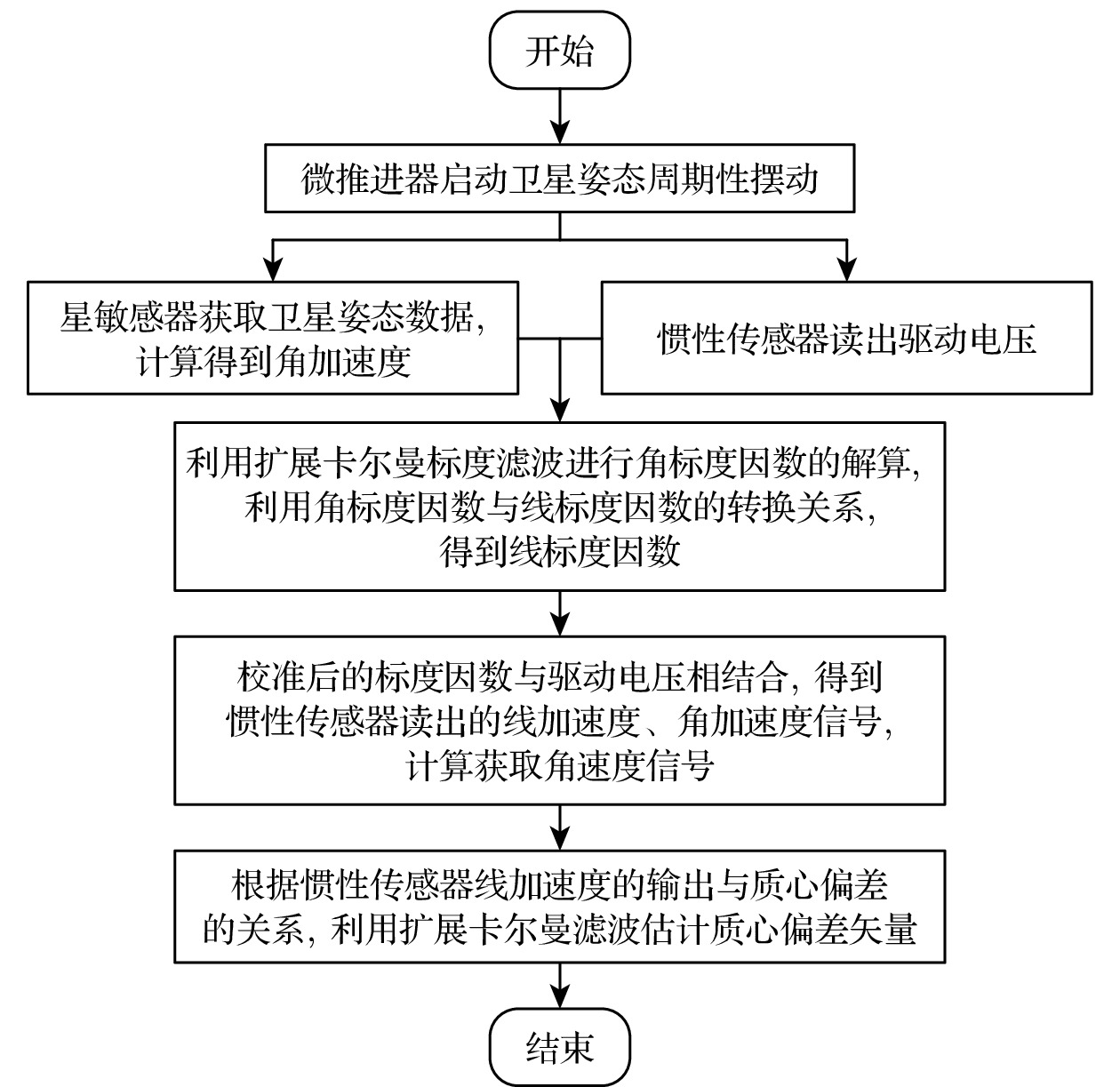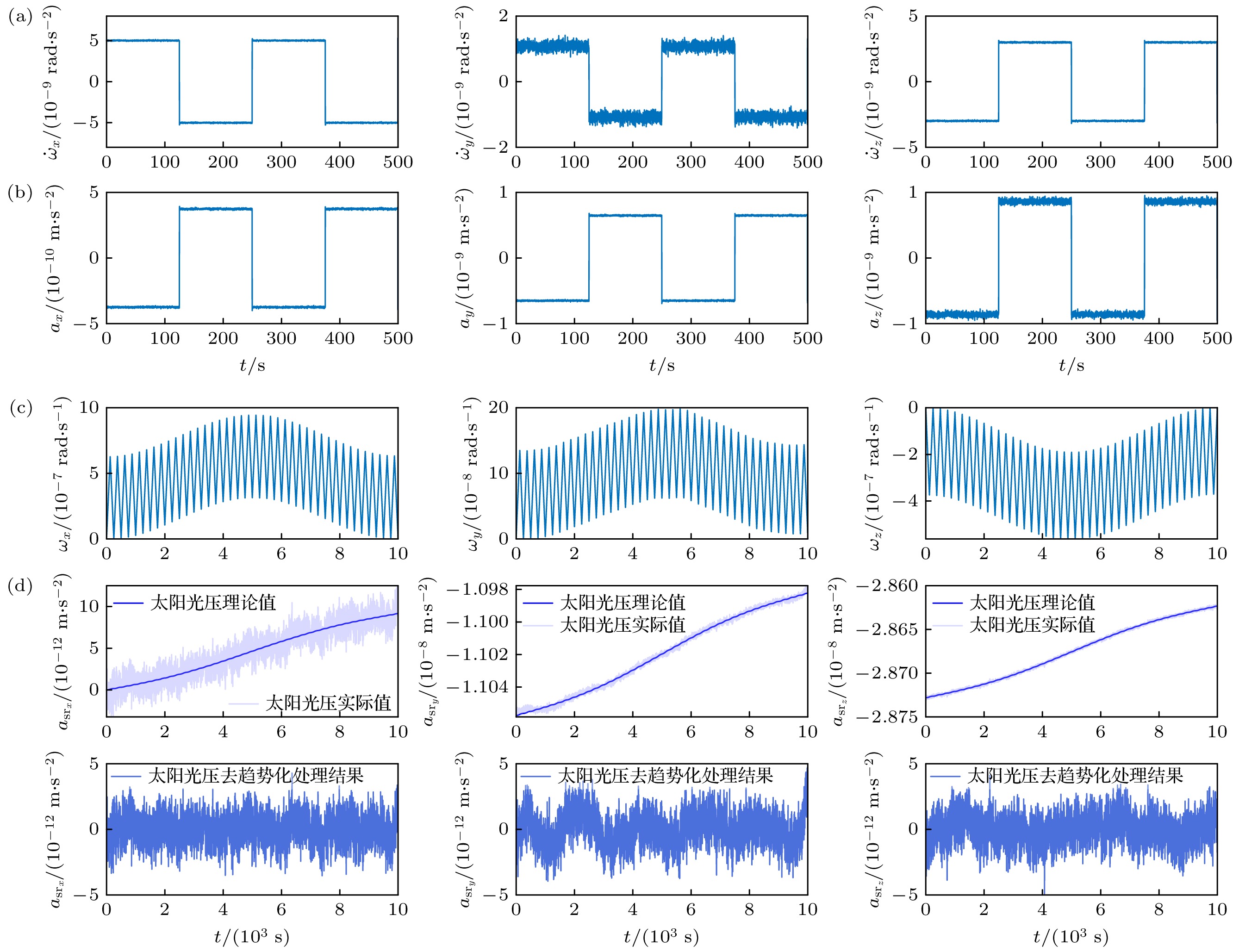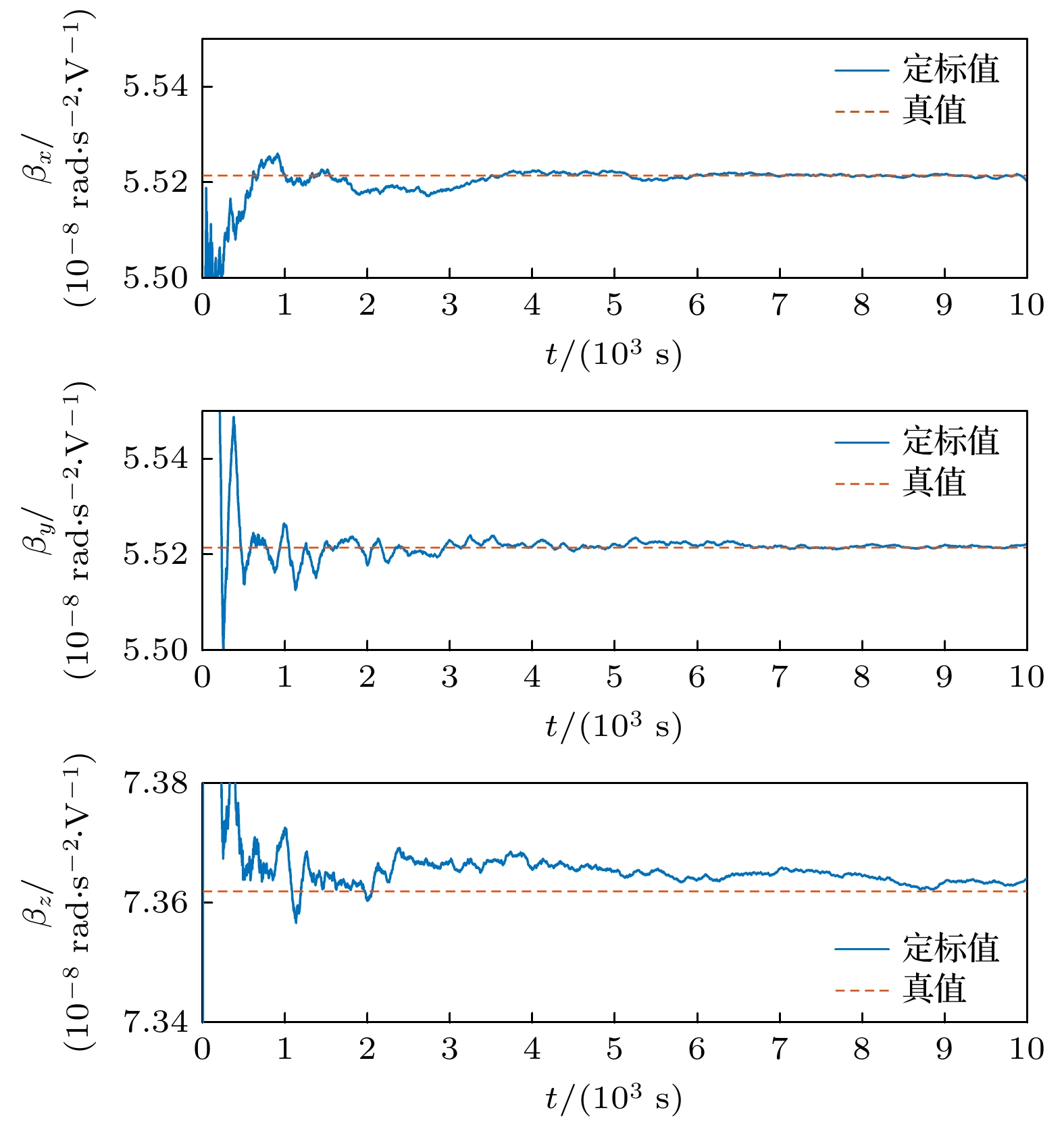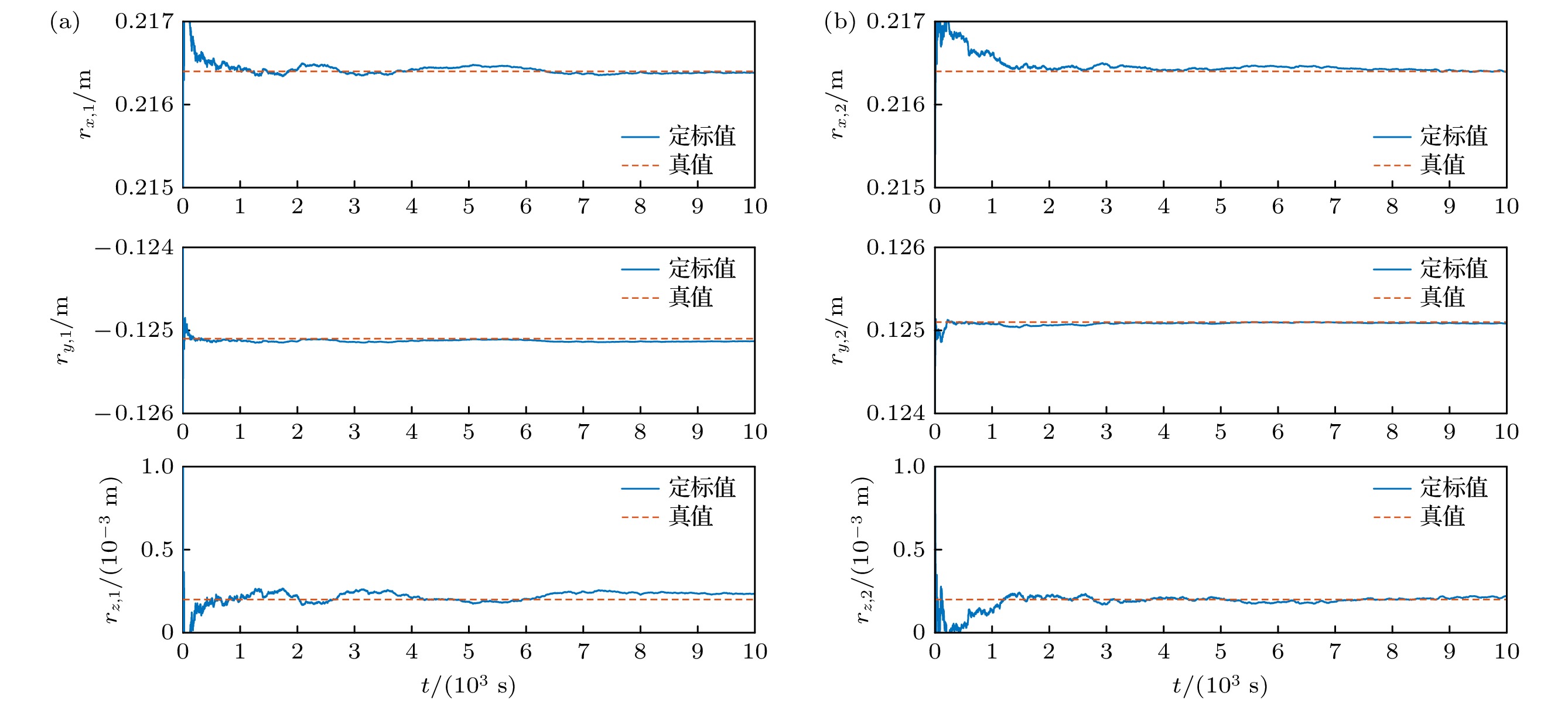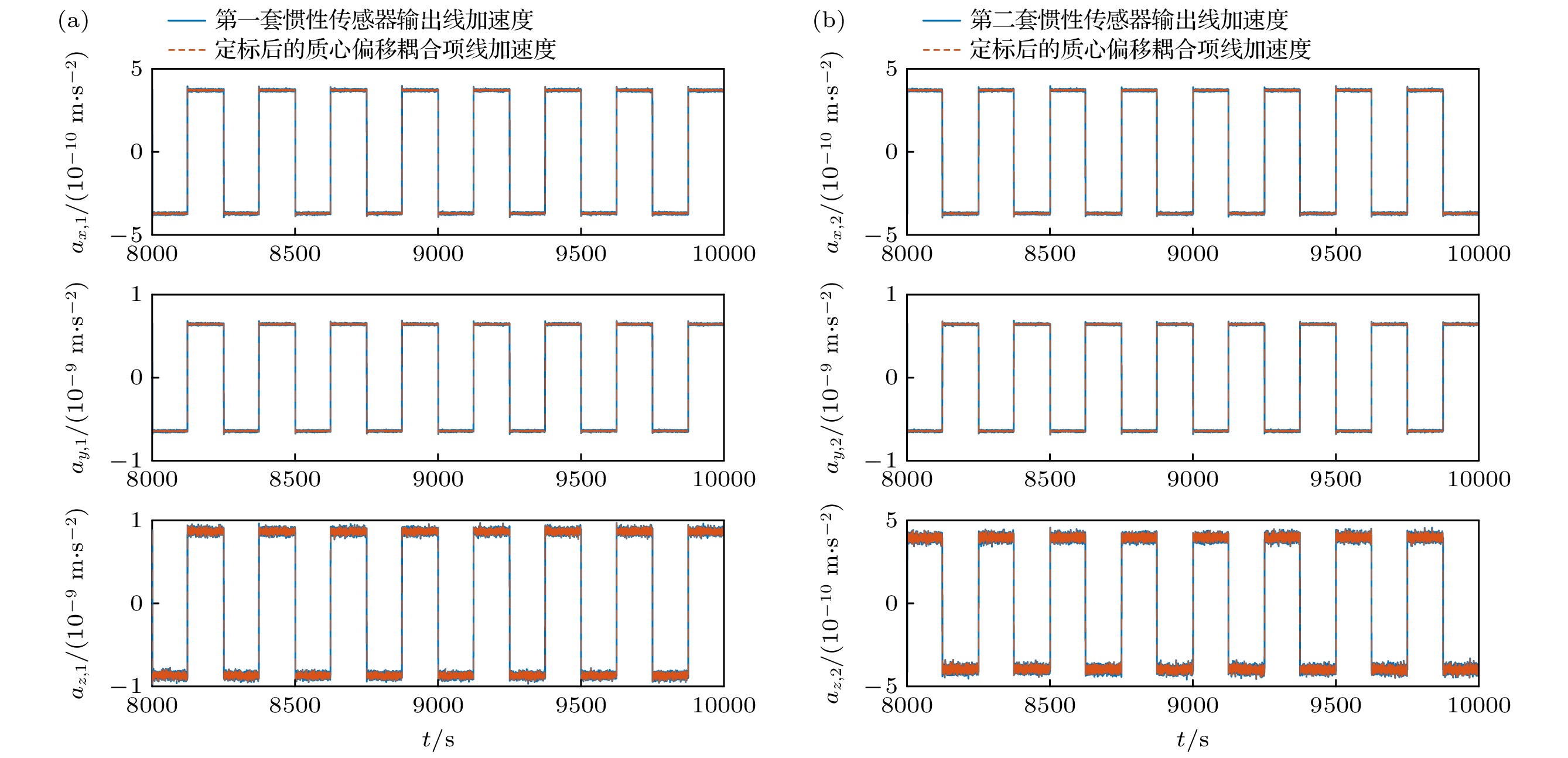-
星载超高精度惯性传感器是空间引力波探测任务的核心载荷之一. 运行环境差异、卫星工质消耗和电子器件老化会导致惯性传感器主要在轨工作参数与地面定标结果不一致, 影响数据产品精度, 进而影响科学数据质量, 需开展惯性传感器工作参数在轨标定工作. 本文针对空间引力波探测太极计划残余加速度噪声优于3×10–15 m/(s2·Hz1/2)@3 mHz的超高精度指标要求, 结合太极计划惯性传感器设计布局以及实际噪声模型, 设计了惯性传感器标度因数和质心偏差矢量参数在轨定标方案, 并通过仿真实验验证了方案的可行性. 仿真结果表明, 标度因数的在轨定标相对误差小于0.03%, 质心偏差在轨定标单轴误差$ < 75\;{\text{μm} }$, 满足太极计划惯性传感器工作参数在轨定标精度要求.
The Taiji program-frequency gravitational waves. The mission's success hinges on the precise operation of its core payloads, particularly the inertial sensors, which are responsible for measuring the residual acceleration noise of the test masses. The duration of a space-based gravitational wave detection mission is 3 to 5 years. During this period, the shift in the satellite’s center of mass due to propellant consumption and other factors, as well as the drift in the scale factors caused by electronic component aging, will gradually degrade the accuracy of inertial sensor data. Therefore, it is necessary to regularly perform in-orbit calibration of inertial sensor parameters. In this work, we develop a calibration scheme, which actively applies controlled satellite oscillations and is tailored according to the installation layout of the inertial sensors in the Taiji program and the noise models. For the calibration of scale factors, high-precision star sensors are used to measure the satellite attitude signal, which is then combined with the driving voltage data from inertial sensors. By using the linear relationship between these signals, the scale factors are estimated using an extended Kalman Filter. For the calibration of center of mass (CoM) offsets, the calibrated scale factors are utilized, along with the driving voltage data from the front-end electronics of inertial sensors, to derive the test mass’s angular acceleration, linear acceleration, and angular velocity. These parameters are then used to complete the CoM offset calibration according to the dynamic equation. The feasibility of the proposed calibration scheme is validated through a simulation experiment. The results demonstrate that the scale factors of the three axes can be calibrated to relative accuracies of 33×10–6 and 173×10–6, respectively, meeting the requirement within 300×10–6. The CoM deviation are calibrated with accuracies of $ {\delta }_{{\boldsymbol{r}}_{1}}= $[15 μm, 31 μm, 34 μm], $ {\delta }_{{\boldsymbol{r}}_{2}}= $[5 μm, 15 μm, 13 μm], satisfying the 75 μm threshold. These results confirm that the proposed scheme can effectively maintain the inertial sensors’ performance within the required accuracy range. All in all, the calibration scheme developed in this study is crucial for maintaining the high performance of inertial sensors in the Taiji program. By achieving the precise calibration of the scale factors and deviation of center of mass within the required accuracy ranges, the scheme ensures the reliability of inertial sensor data, thereby significantly enhancing the sensitivity of space-based gravitational wave detection, which paves the way for groundbreaking discoveries in astrophysics and cosmology. -
Keywords:
- inertial sensor /
- in-orbit calibration /
- scale factor /
- center of mass offset
[1] Marion F, LIGO Scientific Collaboration 2017 Nuovo Cimento C 39 310
[2] Pinard L, Michel C, Sassolas B, Balzarini L, Degallaix J, Dolique V, Flaminio R, Forest D, Granata M, Lagrange B, Straniero N, Teillon J, Cagnoli G 2017 Appl. Opt. 56 C11
 Google Scholar
Google Scholar
[3] Aso Y, Michimura Y, Somiya K, Ando M, Miyakawa O, Sekiguchi T, Tatsumi D, Yamamoto H 2013 Phys. Rev. D 88 173
 Google Scholar
Google Scholar
[4] KAGRA Collaboration 2019 Nat. Astron. 3 35
 Google Scholar
Google Scholar
[5] Black E D, Gutenkunst R N 2003 Am. J. Phys. 71 365
 Google Scholar
Google Scholar
[6] Jani K, Shoemaker D, Cutler C 2019 Nat. Astron. 4 260
 Google Scholar
Google Scholar
[7] Jennrich O 2009 Class. Quantum Grav. 26 153001
 Google Scholar
Google Scholar
[8] Gong X F, Lau Y K, Xu S N, Amaro-Seoane P, Bai S, Bian X, Cao Z J, Chen G R, Chen X, Ding Y W, Dong P, Gao W, Heinzel G, Li M, Li S, Liu F K, Luo Z R, Shao M X, Spurzem R, Sun B S, Tang W L, Wang Y, Xu P, Yu P, Yuan Y F, Zhang X M, Zhou Z B 2014 J. Phys.: Conf. Ser. 610 12011
[9] Karsten D, the LISA study team 1996 Class. Quantum Grav. 3 A247
 Google Scholar
Google Scholar
[10] Audley H, Babak S, Baker J, et al. 2017 arXiv.1702.00786 [astro-ph.IM]
[11] Sato S, Aso Y, Mino Y, Miyakawa O, Somiya K 2017 J. Phys. Conf. Ser. 840 012010
 Google Scholar
Google Scholar
[12] Kawamura S, Ando M, Seto N, et al. 2011 Class. Quantum Grav. 28 9
 Google Scholar
Google Scholar
[13] Hu W R, Wu Y L 2017 Natl. Sci. Rev. 4 685
 Google Scholar
Google Scholar
[14] Wu Y L, Luo Z R, Wang J Y, Bai M, Zou Z M 2021 Commun. Phys. 4 34
 Google Scholar
Google Scholar
[15] Luo J, Chen L S, Duan H Z, Gong Y G, Hu S, Ji J, Liu Q, Mei J, Milyukov V, Sazhin M 2015 Class. Quantum Grav. 33 035010
 Google Scholar
Google Scholar
[16] 罗子人, 张敏, 靳刚, 吴岳良, 胡文瑞 2020 深空探测学报 7 3
Luo Z R, Zhang M, Jin G, Wu Y L, Hu W R 2020 J. Deep Space Explor. 7 3
[17] Luo Z R, Zhang M, Wu Y L 2022 Chin. J. Space Sci. 42 536
 Google Scholar
Google Scholar
[18] Sun K X, Johann U, Debra1 D B, Byer R L 2007 J. Phys. Conf. Ser. 60 272
 Google Scholar
Google Scholar
[19] 王少鑫, 郭纬川, 赵平安, 王娟, 董鹏, 徐鹏, 罗子人, 齐克奇 2024 中国科学: 物理学 力学 天文学 54 91
 Google Scholar
Google Scholar
Wang S X, Guo W C, Zhao P A, Wang J, Dong P, Xu P, Luo Z R, Qi K Q 2024 Sci. Sin. Phys. Mech. Astron. 54 91
 Google Scholar
Google Scholar
[20] Wei X T, Huang L, Shen T Y, Cai Z M, He J B 2023 Phys. Rev. D 108 082001
 Google Scholar
Google Scholar
[21] Visser P N A M, Ijssel J V D 2003 Adv. Space Res. 31 1905
 Google Scholar
Google Scholar
[22] Lenoir B, Christophe B, Reynaud S 2012 Measurement 46 1411
[23] Visser P N A M 2008 J. Geod. 82 591
 Google Scholar
Google Scholar
[24] Wang F R 2003 Ph. D. Dissertation (Austin: The University of Texas at Austin
[25] Zhang H Y, Xu P, Ye Z, Ye D, Qiang L E, Luo Z R, Qi K Q, Wang S X, Cai Z M, Wang Z L, Lei J G, Wu Y L 2023 Remote Sens. 15 3817
 Google Scholar
Google Scholar
[26] 阮远东, 章志昊, 贾茳勰, 顾煜宁, 张善端, 崔旭高, 洪葳, 白彦峥, 田朋飞 2024 73 220401
 Google Scholar
Google Scholar
Ruan Y D, Zhang Z H, Jia J X, Gu Y N, Zhang S D, Cui X G, Hong W, Bai Y Z, Tian P F 2024 Acta Phys. Sin. 73 220401
 Google Scholar
Google Scholar
[27] Lupi F 2019 M. S. Thesis (Delft: Delft University of Technology
[28] Blarre L, Ouaknine J, Oddos-Marcel L, Brévannes L, Martinez P-E, Belin É 2006 AIAA Guidance, Navigation and Control Conference, Colorado, August 21–24, 2006 p6046
[29] 袁利, 王苗苗, 武延鹏, 王利, 郑然 2020 航空学报 4 17
Yuan L, Wang M M, Wu Y P, Wang L, Zheng R 2020 Chin. J. Aeronaut. 4 17
[30] Liu H, Niu X, Zeng M, Wang S, Cui K, Yu D R 2022 Acta Astronaut. 193 496
 Google Scholar
Google Scholar
[31] 于达仁, 牛翔, 王泰卜, 王尚胜, 曾明, 崔凯, 刘辉, 涂良成, 李祝, 黄祥青, 刘建平, 沈岩, 彭慧生, 杨铖, 宋培义, 匡双阳, 张开, 索晓晨, 黄潇博, 刘旭辉, 汪旭东, 龙军, 付新菊, 高晨光, 杨涓, 夏旭, 付瑜亮, 胡展, 康小明, 吴勤勤, 庞爱平, 周鸿博 2021 中山大学学报: 自然科学版 60 194
Yu D R, Niu X, Wang T B, Wang S S, Zeng M, Cui K, Liu H, Tu L C, Li Z, Huang X Q, Liu J P, Shen Y, Peng H S, Yang C, Song P Y, Kuang S Y, Zhang K, Suo X C, Huang X B, Liu X H, Wang X D, Long J, Fu X J, Gao C G, Yang Juan, Xia Xu, Fu Y L, Hu Z, Kang X M, Wu Q Q, Pang A P, Zhou H B 2021 Acta Sci. Nat. Univ. Sunyatseni. 60 194
[32] 张俊 2016 博士学位论文 (北京: 中国空间技术研究院北京控制工程研究所)
Zhang J 2016 Ph. D. Dissertation (Beijing: Beijing Institute of Control Engineering, Chinese Academy of Space Technology
[33] 门斯布吕克, 吉尔 (王家松, 祝开建, 胡小工 译) 2012卫星轨道: 模型、方法和应用 (北京: 国防工业出版社)第73—79页
Montenbruck O, Gill E (translated by Wang J S, Zhu K J, Hu X G) 2012 Satellite Orbits: Models, Methods and Applications (Beijing: National Defense Industry Press) pp73–79
-
图 5 质心偏差定标期间惯性传感器测量数据模拟信号 (a) 角加速度前500 s仿真信号; (b) 线加速度前500 s仿真信号; (c) 角速度仿真信号; (d)太阳光压仿真信号及处理结果
Fig. 5. Simulation signal of measurement data during mass center offset calibration of inertial sensor: (a) Angular acceleration simulation signal before 500 s; (b) simulation signal of linear acceleration before 500 s; (c) angular velocity simulation signal; (d) simulation signal of sunlight pressure and processing results.
表 1 施加的加速度与驱动电压的对应关系
Table 1. Acceleration corresponds to the excitation voltage.
角加速度和线加速度 标度因数和电压读出 $ {\dot{\omega }}_{x}$ $ \beta_x({V}_{y, 1}-{V}_{y, 2}) $ $ {\dot{\omega }}_{y}$ $ {{{\beta }}}_{{{y}}}({V}_{z, 1}-{V}_{z, 2}) $ $ {\dot{\omega }}_{z}$ $ {{{\beta }}}_{{{z}}}( {V}_{x, 1}-{V}_{x, 2}) $ $ {a}_{x}$ $ {{{k}}}_{{{x}}}({V}_{x, 1}+{V}_{x, 2}) $ $ {a}_{y}$ $ {{{k}}}_{{{y}}}({V}_{y, 1}+{V}_{y, 2}) $ $ {a}_{z} $ $ {{{k}}}_{{{z}}}({V}_{z, 1}+{V}_{z, 2}) $ 表 2 标度因数真值与定标结果
Table 2. Comparison of true scale factor values and calibration results.
标度因数 真值 定标值 βx/(10–8 rad·s–2·V–1) 5.52143 5.52125$ \pm $0.000029 βy/(10–8 rad·s–2·V–1) 5.52143 5.52158$ \pm $0.000022 βz/(10–8 rad·s–2·V–1) 7.36191 7.36318$ \pm $0.000022 kx/(10–9 m·s–2·V–1) 2.25765 2.25804$ \pm 0 $.000007 ky/(10–9 m·s–2·V–1) 1.12883 1.12879$ \pm 0 $.000006 kz/(10–9 m·s–2·V–1) 1.12883 1.12886$ \pm 0 $.000004 表 3 质心偏差真值与定标结果对比
Table 3. Comparison of true values and calibration results of mass center offset.
质心偏差 真值/m 定标值/m $ {\boldsymbol{r}}_{1} $ $ {r}_{x, 1} $ 0.216400 0.216385$ \pm $0.0000014 $ {r}_{y, 1} $ –0.125100 –0.125131$ \pm $0.0000005 $ {r}_{z, 1} $ 0.000200 0.000234$ \pm $0.0000009 $ {\boldsymbol{r}}_{2} $ $ {r}_{x, 2} $ 0.216400 0.216405$ \pm $0.0000067 $ {r}_{y, 2} $ 0.125100 0.125085$ \pm $0.0000022 $ {r}_{z, 2} $ 0.000200 0.000213$ \pm $0.0000046 -
[1] Marion F, LIGO Scientific Collaboration 2017 Nuovo Cimento C 39 310
[2] Pinard L, Michel C, Sassolas B, Balzarini L, Degallaix J, Dolique V, Flaminio R, Forest D, Granata M, Lagrange B, Straniero N, Teillon J, Cagnoli G 2017 Appl. Opt. 56 C11
 Google Scholar
Google Scholar
[3] Aso Y, Michimura Y, Somiya K, Ando M, Miyakawa O, Sekiguchi T, Tatsumi D, Yamamoto H 2013 Phys. Rev. D 88 173
 Google Scholar
Google Scholar
[4] KAGRA Collaboration 2019 Nat. Astron. 3 35
 Google Scholar
Google Scholar
[5] Black E D, Gutenkunst R N 2003 Am. J. Phys. 71 365
 Google Scholar
Google Scholar
[6] Jani K, Shoemaker D, Cutler C 2019 Nat. Astron. 4 260
 Google Scholar
Google Scholar
[7] Jennrich O 2009 Class. Quantum Grav. 26 153001
 Google Scholar
Google Scholar
[8] Gong X F, Lau Y K, Xu S N, Amaro-Seoane P, Bai S, Bian X, Cao Z J, Chen G R, Chen X, Ding Y W, Dong P, Gao W, Heinzel G, Li M, Li S, Liu F K, Luo Z R, Shao M X, Spurzem R, Sun B S, Tang W L, Wang Y, Xu P, Yu P, Yuan Y F, Zhang X M, Zhou Z B 2014 J. Phys.: Conf. Ser. 610 12011
[9] Karsten D, the LISA study team 1996 Class. Quantum Grav. 3 A247
 Google Scholar
Google Scholar
[10] Audley H, Babak S, Baker J, et al. 2017 arXiv.1702.00786 [astro-ph.IM]
[11] Sato S, Aso Y, Mino Y, Miyakawa O, Somiya K 2017 J. Phys. Conf. Ser. 840 012010
 Google Scholar
Google Scholar
[12] Kawamura S, Ando M, Seto N, et al. 2011 Class. Quantum Grav. 28 9
 Google Scholar
Google Scholar
[13] Hu W R, Wu Y L 2017 Natl. Sci. Rev. 4 685
 Google Scholar
Google Scholar
[14] Wu Y L, Luo Z R, Wang J Y, Bai M, Zou Z M 2021 Commun. Phys. 4 34
 Google Scholar
Google Scholar
[15] Luo J, Chen L S, Duan H Z, Gong Y G, Hu S, Ji J, Liu Q, Mei J, Milyukov V, Sazhin M 2015 Class. Quantum Grav. 33 035010
 Google Scholar
Google Scholar
[16] 罗子人, 张敏, 靳刚, 吴岳良, 胡文瑞 2020 深空探测学报 7 3
Luo Z R, Zhang M, Jin G, Wu Y L, Hu W R 2020 J. Deep Space Explor. 7 3
[17] Luo Z R, Zhang M, Wu Y L 2022 Chin. J. Space Sci. 42 536
 Google Scholar
Google Scholar
[18] Sun K X, Johann U, Debra1 D B, Byer R L 2007 J. Phys. Conf. Ser. 60 272
 Google Scholar
Google Scholar
[19] 王少鑫, 郭纬川, 赵平安, 王娟, 董鹏, 徐鹏, 罗子人, 齐克奇 2024 中国科学: 物理学 力学 天文学 54 91
 Google Scholar
Google Scholar
Wang S X, Guo W C, Zhao P A, Wang J, Dong P, Xu P, Luo Z R, Qi K Q 2024 Sci. Sin. Phys. Mech. Astron. 54 91
 Google Scholar
Google Scholar
[20] Wei X T, Huang L, Shen T Y, Cai Z M, He J B 2023 Phys. Rev. D 108 082001
 Google Scholar
Google Scholar
[21] Visser P N A M, Ijssel J V D 2003 Adv. Space Res. 31 1905
 Google Scholar
Google Scholar
[22] Lenoir B, Christophe B, Reynaud S 2012 Measurement 46 1411
[23] Visser P N A M 2008 J. Geod. 82 591
 Google Scholar
Google Scholar
[24] Wang F R 2003 Ph. D. Dissertation (Austin: The University of Texas at Austin
[25] Zhang H Y, Xu P, Ye Z, Ye D, Qiang L E, Luo Z R, Qi K Q, Wang S X, Cai Z M, Wang Z L, Lei J G, Wu Y L 2023 Remote Sens. 15 3817
 Google Scholar
Google Scholar
[26] 阮远东, 章志昊, 贾茳勰, 顾煜宁, 张善端, 崔旭高, 洪葳, 白彦峥, 田朋飞 2024 73 220401
 Google Scholar
Google Scholar
Ruan Y D, Zhang Z H, Jia J X, Gu Y N, Zhang S D, Cui X G, Hong W, Bai Y Z, Tian P F 2024 Acta Phys. Sin. 73 220401
 Google Scholar
Google Scholar
[27] Lupi F 2019 M. S. Thesis (Delft: Delft University of Technology
[28] Blarre L, Ouaknine J, Oddos-Marcel L, Brévannes L, Martinez P-E, Belin É 2006 AIAA Guidance, Navigation and Control Conference, Colorado, August 21–24, 2006 p6046
[29] 袁利, 王苗苗, 武延鹏, 王利, 郑然 2020 航空学报 4 17
Yuan L, Wang M M, Wu Y P, Wang L, Zheng R 2020 Chin. J. Aeronaut. 4 17
[30] Liu H, Niu X, Zeng M, Wang S, Cui K, Yu D R 2022 Acta Astronaut. 193 496
 Google Scholar
Google Scholar
[31] 于达仁, 牛翔, 王泰卜, 王尚胜, 曾明, 崔凯, 刘辉, 涂良成, 李祝, 黄祥青, 刘建平, 沈岩, 彭慧生, 杨铖, 宋培义, 匡双阳, 张开, 索晓晨, 黄潇博, 刘旭辉, 汪旭东, 龙军, 付新菊, 高晨光, 杨涓, 夏旭, 付瑜亮, 胡展, 康小明, 吴勤勤, 庞爱平, 周鸿博 2021 中山大学学报: 自然科学版 60 194
Yu D R, Niu X, Wang T B, Wang S S, Zeng M, Cui K, Liu H, Tu L C, Li Z, Huang X Q, Liu J P, Shen Y, Peng H S, Yang C, Song P Y, Kuang S Y, Zhang K, Suo X C, Huang X B, Liu X H, Wang X D, Long J, Fu X J, Gao C G, Yang Juan, Xia Xu, Fu Y L, Hu Z, Kang X M, Wu Q Q, Pang A P, Zhou H B 2021 Acta Sci. Nat. Univ. Sunyatseni. 60 194
[32] 张俊 2016 博士学位论文 (北京: 中国空间技术研究院北京控制工程研究所)
Zhang J 2016 Ph. D. Dissertation (Beijing: Beijing Institute of Control Engineering, Chinese Academy of Space Technology
[33] 门斯布吕克, 吉尔 (王家松, 祝开建, 胡小工 译) 2012卫星轨道: 模型、方法和应用 (北京: 国防工业出版社)第73—79页
Montenbruck O, Gill E (translated by Wang J S, Zhu K J, Hu X G) 2012 Satellite Orbits: Models, Methods and Applications (Beijing: National Defense Industry Press) pp73–79
计量
- 文章访问数: 2612
- PDF下载量: 82
- 被引次数: 0














 下载:
下载:
